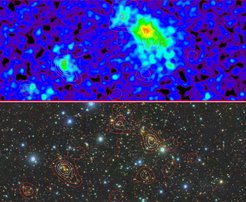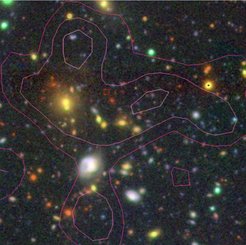Matthias Klein
"The job situation regarding permanent positions is insane in academia"

Life
My name is Matthias Klein, I am “Akademischer Rat” at the LMU in Prof. Joseph Mohr’s group. I am coming from a little town near Koblenz, settled in the Rhine valley famous for its medieval castles. I studied in Heidelberg physics and did my diploma thesis in astronomy at the Landessternwarte Heidelberg, on top of Mount Königsstuhl over the beautiful city of Heidelberg. After that I went to the University of Bonn for my PhD in Astrophysics, starting to work on galaxy clusters as I do today. During that time I could enjoy seven trip to Chile for doing observations for my PhD project. An experience that I will never forget. After my PhD I moved to Munich for a postdoc at MPE followed by my current position as Akademischer Rat at the LMU. With these new positions I got access to some of the greatest astronomical data sets in the world (DES, SPT, eROSITA) allowing a mind-blowing number of great scientific projects.
Besides curiosity how the universe works, I partially see myself an explorer. The feeling that I am looking at something that no human being has seen before is hardly to describe. Especially if you realise that you look that far back in time when Earth und Sun haven’t been existing at all.
Science
My most general field of interest is called extragalactic astronomy, so everything that lies outside the milky way. My current main interests are on galaxy clusters and the evolution of galaxies that are part to them. As the name suggests they visually seem to consist of an ensemble of galaxies. But as often in life, nothing really is at it seems from the first look. The galaxies in the cluster are actually the smallest portion when it comes to mass. The majority of the mass is coming from dark matter, a material we actually don’t really know what it is and the other part is in form of extremely hot gas that fills out the space between the galaxies in the cluster. In fact this gas is that what eROSITA uses to find galaxy clusters, as it emits X-ray light.
There are many ways to identify galaxy clusters, each with pros and cons. In case of eROSITA one finds galaxy clusters as as extended sources (fuzzy blobs) in X-rays, which allows them to distinguish from other X-ray sources like AGN. X-ray observations promise a good way to find galaxy clusters over a huge redshift range with an understandable selection function and low contamination. What astronomers understand under selection function is that one knows for a given set of cluster parameters what fraction of these clusters one finds and equally important which ones are missed. The contamination is also an important quantity as one wants to know not only what clusters are missed or found but how many of the sources we think are clusters are actually clusters.

Why is that all important and what is my (works) role in this context? Well, the number of galaxy clusters at a given mass and redshift/time depends on the properties of the universe itself (e.g. how much matter exists that can clump into clusters). So if one does count the clusters in mass and redshift (like a stocktaking of the universe) one can learn about the universe and its constituent as such. Obviously, for doing that one needs to account for the clusters missed, the sources that you think are clusters but aren’t and what redshift and mass they have.
My work, or better say our work (as science is always team work), adds information from optical observations to the X-ray data to derive the redshifts of the clusters, allows to figure out which of the X-ray sources are actually no clusters and estimates how many real cluster we may loose when we use these optical data to clean the X-ray cluster candidates from nonclusters. Additionally it adds another indicator for cluster mass to those provided by X-rays, which is related to the number of galaxies in the galaxy cluster. With that this work is actually touching every aspect mentioned.
In the current work we used data from the 8m Subaru telescope in Hawaii and the 4m Blanco telescope in Chile, which imaged the eROSITA eFEDS region in optical bands. With that we could estimate the redshifts of the galaxy clusters as well their probability of being a chance superposition and the number of galaxies in the cluster. Using that we could not only measure the number of contaminants in the X-ray catalog to be consistent with expectations from simulations. We could actually show that we are able to exclude great parts of that contamination without loosing significant amount of real galaxy clusters. So at the end the combination of X-ray and optical data yields a catalog that profits from the positive side of being an X-ray selected sample without having high contamination or lack of redshifts.

Besides this optical images can be used, with or without information from Xrays, to study the dynamical state of galaxy clusters. Galaxy clusters are no static entities they evolve over time and merge with other cluster in gigantic collisions. Those merging systems are therefore interesting astrophysical probes. In our recent work we make use of the distribution of the galaxies in the galaxy cluster as well as their distance to neighbouring X-ray clusters to identify such merging systems.
Future Projects
I am involved in many ongoing projects, one is related to the South Pole Telescope (SPT) and uses optical data from the Dark Energy Survey (DES). This work includes more than twice as many clusters as in this current analysis and given there higher redshift puts again new demands on the understanding of those systems and their optical properties.
Hobbys
In the past I actually had a bunch of hobbies, but now that my little daughter is there (she will get 2 around the time of the press release) my whole spare time is going into the aim of being a good dad.
Conclusion
I never thought when I was 16 years old and was watching alpha centauri with Harald Lesch (for non-Germans: He might be the closest german pendant to Neil deGrass Tyson) that I will study astronomy and will end-up in an office right next door with him. If I would tell that to the 16 year version of me and would add that my daughter has actually on the same day birthday, he wouldn’t believe me.
I might have left academia already if I would start from the beginning. The job situation regarding permanent positions is insane in academia and one ask your self how deep is my wish to do this job. The job as such is indeed interesting and perfect for someone who wants to be a discoverer. So if you love doing science and you are willing to put most of your energy in it you will get payed back with an inspiring job and hopefully a permanent position. If you are someone who just like this job like any other ordinary job, then you should better think of going for a career outside science.














